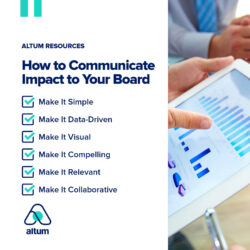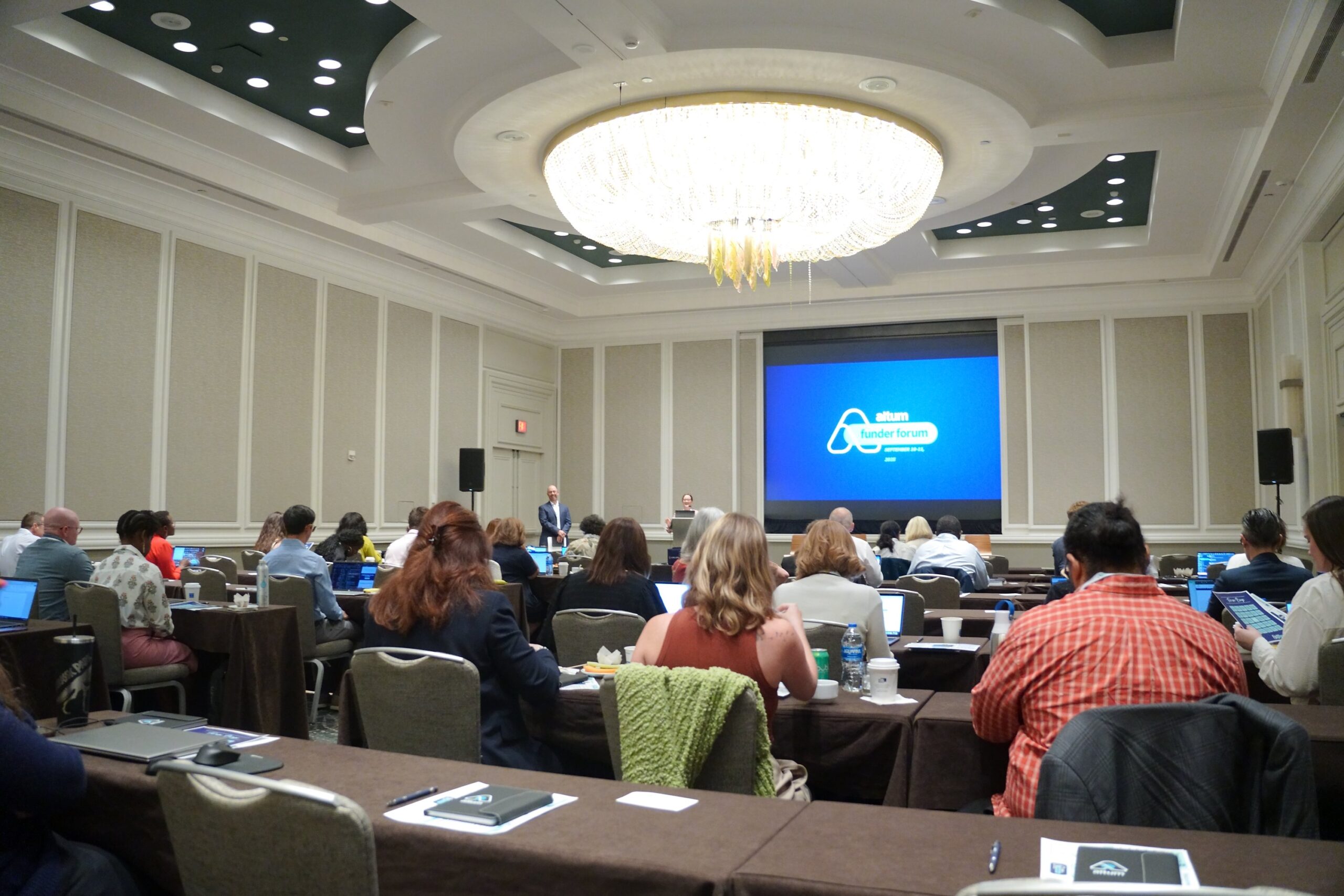There are numerous critical audiences invested in the success and grant impact of research initiatives, yet none are as influential as an organization’s board.
This central body typically plays a sizable role in shaping and guiding the trajectory of an organization, lending expertise and connections, and raising challenges and opportunities.
So when it comes to clearly defining and showcasing grant impact and its implications for scientific research more widely, this is one of your most valuable—and critical—audiences.
At Altum, we believe research is the heart of innovation and the catalyst for advancement. But the truth is, the topic of assessing ROI and the impact of research funding is far from straightforward. So how do we show progress, potential, and above all, impact, to this invaluable governing body? With six key strategies.
By using these six simple principles to communicate impact to your board, you’ll optimize their response, deepen their sense of partnership, and drive future collaboration over time.
Simplify Complex Research Impact Statements
First and foremost, focus on the big picture. The more you can zoom out on the major ideas or issues the research in question addresses, the more you can clearly exemplify the value and broader overarching implications of the grant funding. Whenever possible, avoid jargon or overly technical terms. You may also want to consider using metaphors or analogies to everyday experiences in order to clearly connect the dots between the potentially complex nature of the research pursuit and more easily understood concepts.
Use Data-Driven Evidence to Demonstrate Grant Impact

While simple is key, so is validating and reinforcing your demonstrated impact through clear metrics. Of course, defining the right success metrics isn’t a universal formula. Quantitative metrics like publications hold weight, but so too can qualitative factors like collaboration and program intent. It’s important to consider metrics-driven means to demonstrate both quantitative and qualitative data points.
This facet of showing impact is particularly central to Altum’s core competencies. Our Altum Analytics product comes with predefined dashboards to explore your ProposalCentral funding data, benchmark your performance, and make more informed decisions—so you can leverage the data at your fingertips to enhance your conversations with the board without adding lots of administrative burden to your already-busy schedule.
For more information about our Altum Analytics product’s most valuable capabilities, visit the product overview webpage.
Visualizing Grant Impact: Engage Your Board
Numbers can tell a convincing story—but dynamically bringing them to life is key to keeping your audience engaged. There are numerous valuable techniques that can help transform spreadsheets into compelling stories. So what should you consider? To start, it’s always valuable to translate statistics and financial figures into simple charts and graphs. From there, you can highlight key milestones using timeline infographics, or tap into illustrations to emphasize the problem or the proposed solution. Perhaps, most striking of all are real photos and video testimonials that can add richness and dimension to your summaries and presentations.
Of course, different people process information in different ways. Plan to share underlying spreadsheets and base metrics as footnotes or in an appendix to supplement more visuals-forward showcases. Consider offering people the option for either digital or hard-copy versions of your reporting, too.
Craft Compelling Narratives to Showcase Research Outcomes
Sometimes the most striking way to drive home the intended or anticipated impact of scientific research is through personal connections or resonant stories. After all, a personal connection to the work is often the reason board members join a particular initiative in the first place. A few tips to do this effectively: Make the researchers the hero of the story. Approach the story from an unexpected angle. Use an analogy or provocative question to engage the audience. And above all, focus on building trust and empathy.
Connect Research Initiatives to Global Outcomes
When we can connect the dots between individual research initiatives or funding allocations, we broaden not only the story but the perceived outcomes as a whole. Grant impact isn’t isolated to the primary grantee. By tracking the broader research team, we can gain a more complete understanding of influence, recognizing that impactful research is often a collaborative endeavor.
Coordinating research reporting with the given topic’s broader applications and implications can also take the story even further. So consider how a particular grant or research initiative could inform future policy-making or shape global outcomes—and don’t be afraid to paint a picture of that vision for board members.
To add one other dimension of relevance to your presentations, you can also consider longitudinal tracking, following both funded and unfunded applicants over time. This not only shows the outcomes of funding but also what might have occurred if other avenues were explored—providing a robust evaluation mechanism to show your particular imprint on the grant strategy.
Foster Collaboration with Transparent Impact Data
Last, but not least, focus on teamwork and transparency. Collaboration across disciplines and funding bodies can potentially unlock co-funding opportunities and shared learnings, principles that are particularly valued by board members and senior leaders. So think about an inclusive and open perspective—because transparency in sharing impact data externally, be it with donors, researchers, or the public, can yield greater accountability and invaluable connections.
For more about our commitment to open science, click here to visit our open research page.

Assessing the impact of research funding—and clearly communicating your takeaways to your board—is a monumental task. It’s a multidimensional challenge that requires both quantitative and qualitative elements, and it’s far from formulaic. But with these 6 core principles in mind, you’ll be more effectively equipped than ever to paint a picture that’s not only effective and interesting, but one that carries resonance well beyond an initial presentation into decision-making and planning conversations for many years to come.

Relevant Reference Links on Grant Impact
- https://gathercontent.com/blog/communicating-research-and-its-impact-through-content
- https://blog.boardsource.org/blog/communicate-effectively-to-create-better-board-relationships
- https://www.linkedin.com/advice/0/what-some-effective-ways-communicate-impact-grants#:~:text=Use%20data%20and%20stories,highlight%20your%20challenges%20and%20opportunities.
- https://fundingforgood.org/how-your-board-contributes-to-the-grant-winning-process/
- https://nonprofithub.org/nonprofit-impact-report-how-to-visually-communicate-your-impact/
- https://fundingforgood.org/how-your-board-contributes-to-the-grant-winning-process/
- https://www.linkedin.com/pulse/8-steps-compelling-research-impact-statement-professor-richard/




